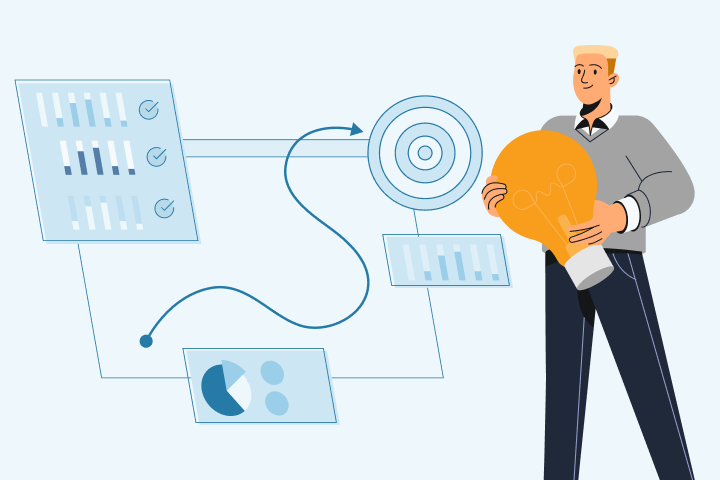Boost Employee Advocacy with Smarter LinkedIn Strategies
Employee advocacy on social media is a powerful way to increase employee engagement, and in turn, your brand’s reach. In fact, 72% of employees would post about their company if the content was written for them. Imagine the brand exposure you’d gain simply by tapping into your employees’ social networks.
If your goal is to drive organic social traffic, generate leads, or both, using LinkedIn for employee advocacy can help you achieve those goals. However, to maximize your employee advocacy on LinkedIn, you need to be strategic.
In this article, we’ll explain the importance of building employee advocacy on LinkedIn, share best practices, and highlight some employee advocacy tools.
Ready to turn your employees into brand advocates on LinkedIn? Let’s get started.
The Importance of Building Employee Advocacy on LinkedIn
By empowering your employees to share relevant, quality content (and interact with others’ content) on LinkedIn, they’ll build trust and exposure for your brand.
Let’s explore some additional benefits of employee advocacy on the platform.
1. Stronger Employer Brand
Increasing brand awareness is often the main reason that companies initially implement a LinkedIn employee advocacy program.
Through a strong employee advocacy program, your employees can shine the spotlight on your business, showing why you’re not only a great brand but also a great employer, too. By contributing to your employer branding on LinkedIn, your workers will show why your company is a great place to work, which will attract the attention of potential top talent.
2. More Company Page Views and Leads
When employees act as brand advocates, they are the drivers of effective LinkedIn lead generation. When your employees endorse you on LinkedIn, potential customers are more likely to visit your company’s page because they value the recommendations of others.
According to employee advocacy statistics, leads generated by employees’ messages are 7x more likely to convert. LinkedIn is also the most powerful channel for capturing high-quality leads in B2B marketing.
3. Better Content Reach and Engagement
Employees’ networks are typically 10x larger than companies’ follower lists on LinkedIn. As a result, their LinkedIn posts appear in front of more people and consequently get more views and interactions. Posts shared by employees also have a 2x higher click-through rate than content shared by companies.
So, when leveraging employee advocacy on LinkedIn, you broaden the scope of your reach and stretch your brand farther into the tenets of the network through employee-generated content.
4. Maximized Social Selling Potential and Profits
It’s easier to harness the power of social selling on LinkedIn via employee advocacy.
Employees who highlight your thought leadership, showcase your brand as authentic and trustworthy. By boosting your brand influence, they help you form new social connections, build meaningful relationships, and drive sales from LinkedIn.
Generally, companies running employee advocacy programs report a 26% increase in year-to-year revenue.
Best Practices for LinkedIn Employee Advocacy
Now that we’ve reviewed the importance and benefits of employee advocacy on LinkedIn, let’s dive into some best practices.
Here are seven winning tactics and strategies for transforming your employees into brand advocates.
1. Develop Content-Sharing Guidelines
First and foremost, create social media guidelines for your employees to protect your brand’s reputation. Your guidelines will explain what content they can (and cannot) post.
Allocate a separate section in your social media policy to discuss the following:
- LinkedIn usage during work hours.
- The company’s tone of voice, mission, and values in posts.
- Respectful communication based on the principles of diversity and inclusion.
- Intellectual property laws concerning trademarks and copyrights of textual, audial, or visual content.
- Confidentiality and data privacy.
According to Volodymyr Shchegel, VP of Engineering at MacKeeper, failure to frame content guidelines for employee advocacy can have serious consequences.
“Failing to frame content guidelines for employee advocacy on LinkedIn can drag you as an employer into a PR scandal with legal consequences. Having clear-cut standards and rules, employees will know exactly what content is appropriate to share on LinkedIn and what is strictly forbidden or confidential. The LinkedIn post may be as innocent as a photo of your employee enjoying the workday. In the meantime, however, the laptop in the background can expose the client’s personal information. This can damage your brand reputation or even land you in the courtroom.”
- Volodymyr Shchegel, VP of Engineering at MacKeeper.
2. Urge New Hires To Share Their Experiences
Encouraging your new hires to share their experiences is a great way to foster engagement and contribute to employee advocacy.
Tom Golubovich, Head of Marketing & Media Relations at Ninja Transfers, believes, “You can hit two targets with a single shot by using your new employees as brand advocates on LinkedIn. It works like this: You engage new hires and get them involved as valuable content contributors at the onboarding stage. At the same time, you enrich your LinkedIn employee advocacy program with fresh content.”
In this example, a new software engineer at Meta shares a recap of his first day, which included a “Welcome to Meta” box full of perks:

Source: Zhongqi Li
In addition to sharing first-day recap posts, new staff members can also write LinkedIn Pulse articles when they hit their six- or 12-month milestone, sharing their experiences with your company thus far.
Here, another Meta employee shares his first-year experience with the company:

Source: Nachi Nagappan
Added bonus: this employee also provides a link to the Careers page for those interested in working for Meta. Smart move.
3. Establish an Employee Spotlight Series
An employee spotlight is content that highlights individual employees or teams and showcases their expertise, accomplishments, and contributions to the company.
When asked which technique helped increase their employee advocacy the most, 61% said employee spotlights.
Some popular content ideas for employee spotlights are:
- Welcome shout-outs to new workers.
- Career advancements.
- Work anniversary celebrations.
- Casual interviews.
- Day-in-the-life videos.
For example, KYYBA Inc. created a series of employee spotlight interviews and shared them via LinkedIn Pulse.

Source: KYYBA Inc
Meanwhile, Jolly SEO likes to show its appreciation by sharing thank-you notes for its employees on LinkedIn.
“As a business or team leader, you can also leave a personalized thank-you note on LinkedIn mentioning the names of employees you’re grateful for. By doing so, you show respect and appreciation for your employees’ achievements. It is a small but significant recognition gesture that may mean a lot to your team members.”
- Greg Heilers, Co-Founder of Jolly SEO.

Source: Greg Heilers
You can later repost such thank-you notes on the company’s page to maximize your employee advocacy efforts on LinkedIn.
4. Promote Your Company Culture
Employee advocacy and company culture go hand-in-hand, each enhancing the other. LinkedIn is one of the best places to emphasize your company’s values through your employees, who will endorse you even more passionately when they feel they are an indispensable part of your culture.
Checkr is a great example of a company that’s building a more diverse and inclusive workplace.
“Promoting diversity, equity, and inclusion (DEI) in the workplace, we strive to make every employee’s voice heard. And our LinkedIn page isn’t an exception. When discussing fair chance hiring initiatives or heritage months (like Black History Month or Pride Month) on LinkedIn, we celebrate people of different backgrounds, ages, genders, races, educational levels, etc.”
- Robert Kaskel, Chief People Officer at Checkr.
In the example below, Checkr shows its support for its employees and Pride Month.

Source: Checkr, Inc.
Then, in another example from Checkr, the company showcases its Fair Chance Apprenticeship program:

Source: Checkr, Inc.
5. Lead by Example
According to Anthony Martin, Founder and CEO of Choice Mutual, leading by example is another valuable method to enhance your employee advocacy strategy on LinkedIn.
“Company leaders and executives can empower their LinkedIn employee influencers by showing an example and maintaining an active presence on the platform. Don’t be afraid to make your LinkedIn engagement contagious. Keep the ball rolling by communicating with your audience and employees and actively interacting with them on LinkedIn.”
- Anthony Martin, Founder and CEO of Choice Mutual.
In this post, Martin announced big company news: Choice Mutual launched a mobile app.

Source: Anthony Martin
In addition to Martin’s advice, here are some additional tips to increase engagement on LinkedIn:
- Share company updates and events.
- Celebrate milestones.
- Unveil behind-the-scenes.
- Create polls.
- Reply to comments.
- Participate in discussions with employees.
6. Organize LinkedIn Training and Education
Providing social media training for employees is key for brands to maximize their employee advocacy efforts on LinkedIn effectively.
Andrew Pierce, CEO at LLC Attorney believes that brands should teach their employees to optimize LinkedIn for lead generation.
“Basically, you should teach your workers to effectively use LinkedIn for lead generation the way you do as a business. Namely, how to optimize the profile, build a professional network, engage with content, and so on.”
- Andrew Pierce, CEO at LLC Attorney.
Here are some key optimization insights from Pierce on what your employees need to know about LinkedIn:
- Account Inactivity. LinkedIn may flag your account as inactive or block it if you don’t show any activity for a certain period.
- Content Adequacy. The content must be professional, safe, and trustworthy, according to LinkedIn’s Professional Community Policies.
- Language. Hate speech and offensive or discriminatory language aren’t tolerated by LinkedIn.
- Engaging Content. Effective LinkedIn content ideas include polls, questions, listicles, and personal stories.
- Posting Frequency. Two or more posts per day may kill your LinkedIn reach, particularly that of your first content piece. Moreover, if you post too much, your account can be flagged for spam and blocked.
Note: Even a single-post-per-day frequency can seem suspicious to LinkedIn.

Source: Belkins
Make sure to train your employees on how to track LinkedIn analytics, measure engagement, and align their posts with the platform’s algorithms to avoid being suspended or banned.
7. Recognize, Reward, and Gamify
Who said employee advocacy on LinkedIn should be a dull process? Employee advocacy can be fun, if you choose to make it fun.
Boost participation by consistently recognizing and rewarding employees who promote your company on LinkedIn. Recognition can be informal (e.g., verbal thank you) or formal (e.g., company-wide rewards program).
Using an employee advocacy tool like GaggleAMP can streamline the process. With GaggleAMP, you can incorporate gamification into your employee advocacy program, motivating your employees to earn points for tasks and rewarding the top participants.
Buurst is just one example of a company who benefitted from using GaggleAMP to boost its employee advocacy efforts. The company gained over 700 website clicks, 1,600 interactions, and 2.5 million reach in just four months by using GaggleAMP.
Ready to Launch Your Biggest Influencers on LinkedIn?
No more leaving your team members on the bench. Let GaggleAMP help you enhance your employee advocacy for LinkedIn and transform your workers into lifelong brand ambassadors on social media.
Book a demo of GaggleAMP today and see how your employees can boost your LinkedIn growth in just one click.











